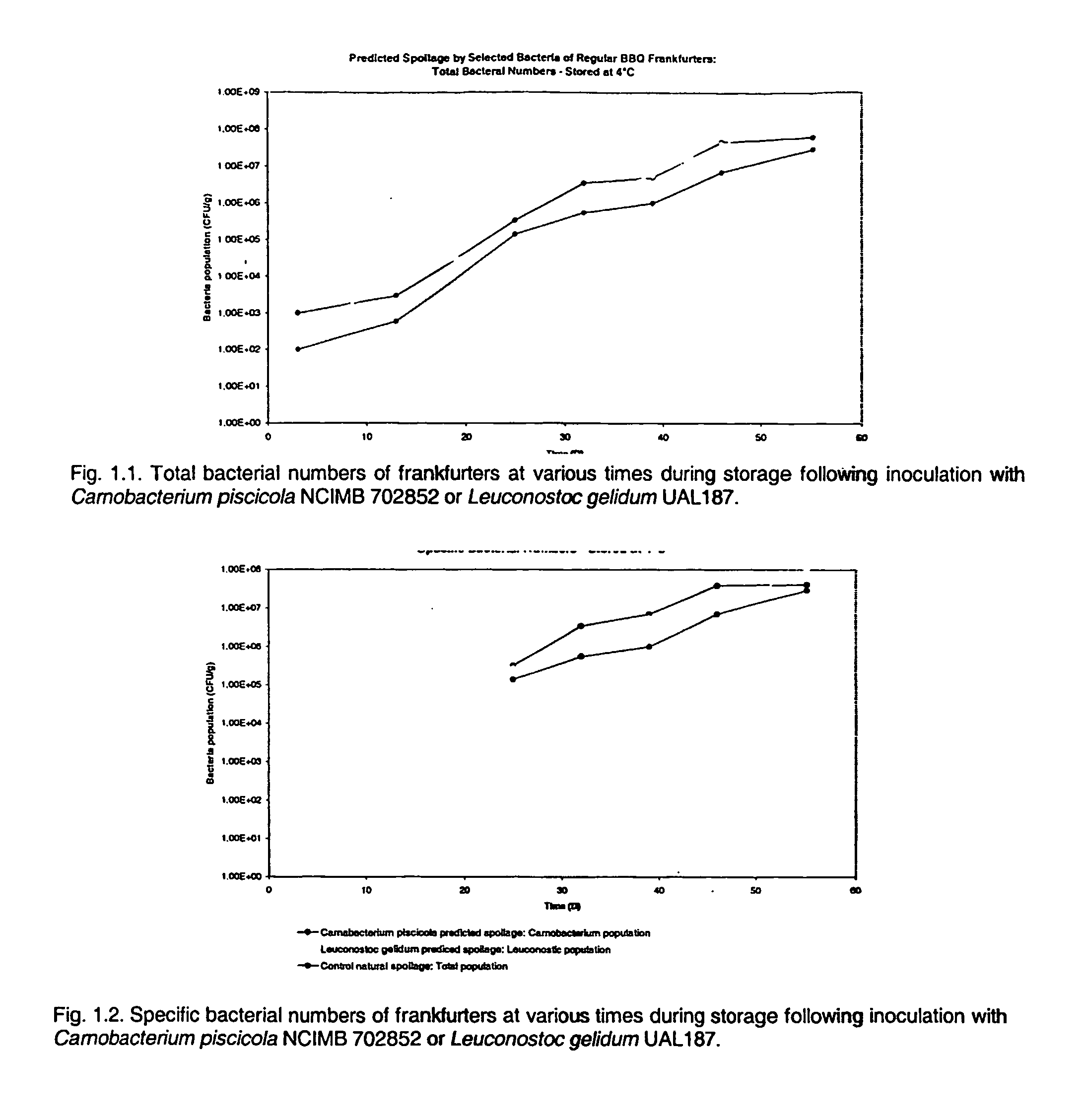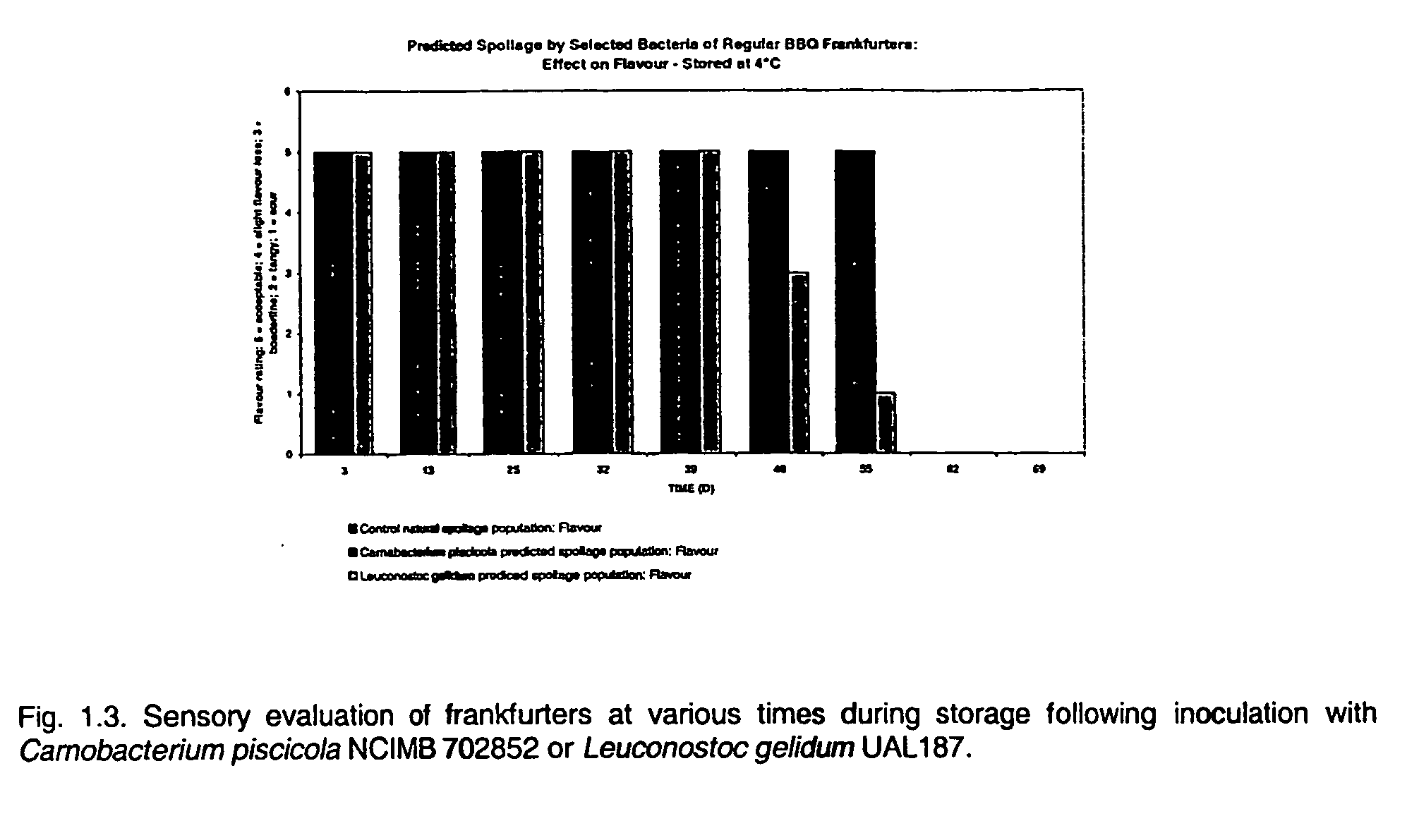Controlled Spoilage Food Compositions
- Summary
- Abstract
- Description
- Claims
- Application Information
AI Technical Summary
Benefits of technology
Problems solved by technology
Method used
Image
Examples
example 1
[0044]This Example illustrates controlled spoilage by selected bacteria of regular BBQ frankfurters.
[0045]Freshly manufactured Regular BBQ frankfurters were inoculated by dipping in cultures of either Carnobacterium piscicola NCIMB 702852 or Leuconostoc gelidum UAL187. For the preparation of inocula, bacteria from frozen culture were subcultured twice in APT broth (Difco; Becton Dickinson) and incubated for 24 hours at 25° C. The cultures of Carnobacterium piscicola NCIMB 702852 or Leuconostoc gelidum UAL187 were standardized with sterile distilled water such that the dipped frankfurters were inoculated with preferably ≦103 per cm2. In the control samples, sterile water was substituted for the cultures. The inoculated frankfurters were dried on a sterile rack and vacuum packaged (2 per pack). The frankfurters were stored at 4° C. At the times indicated in FIGS. 1.1 to 1.3, packages of frankfurters were removed from storage and the total bacterial population, specific bacterial popul...
example 2
[0052]This Example illustrates antimicrobial activity of two strains of Carnobacterium piscicola.
[0053]Three compatible strains of L. monocytogenes (List4, HPB65 and HPB642) were grown separately, centrifuged and washed three times with sterile 0.85% saline and resuspended in sterile 0.85% saline for use as the “Listeria” inoculum “cocktail”. L. monocytogenes CDC 7662 was grown separately and inoculated as a single bacterial culture. The lactic acid bacteria (Carnobacterium piscicola UAL26 or UAL26 / 8A) were grown separately, centrifuged and washed three times with sterile 0.85% saline and resuspended separately in sterile 0.85% saline for use as the “lactic” inocula.
[0054]Freshly prepared, regular frankfurters were obtained from a meat processor in Edmonton and they were inoculated by immersion in the inoculum containing either the washed Listeria cocktail or the single L. monocytogenes culture, and the lactic acid bacterium. The inoculated frankfurters were dried on a sterile rack...
example 3
[0063]This example illustrates the impact of the growth of Carnobacterium piscicola and Leuconostoc gelidum on the sensory characteristics of vacuum packaged frankfurters.
[0064]The following laboratory-scale study was designed to investigate the sensory characteristics of Carnobacterium piscicola and Leuconostoc gelidum on vacuum packaged frankfurters inoculated under controlled conditions.
[0065]Two strains of Carnobacterium piscicola NCIMB 702852 and UAL26 and Leuconostoc gelidum UAL187 were investigated.
[0066]For the preparation of inocula, bacteria from frozen culture were subcultured twice in APT broth (Difco) over 24 hours at room temperature. Cultures were centrifuged (10,000 rpm for 10 min, at 7° C.) and pelleted cells were resuspended with 0.85% sterile saline and washed three times by centrifugation. The final cell pellet was resuspended in 10 mL of sterile 0.85% saline to a final concentration of 1×109 CFU per mL. Prior to dipping, a 10 mL aliquot of washed bacterial cells...
PUM
 Login to View More
Login to View More Abstract
Description
Claims
Application Information
 Login to View More
Login to View More - R&D
- Intellectual Property
- Life Sciences
- Materials
- Tech Scout
- Unparalleled Data Quality
- Higher Quality Content
- 60% Fewer Hallucinations
Browse by: Latest US Patents, China's latest patents, Technical Efficacy Thesaurus, Application Domain, Technology Topic, Popular Technical Reports.
© 2025 PatSnap. All rights reserved.Legal|Privacy policy|Modern Slavery Act Transparency Statement|Sitemap|About US| Contact US: help@patsnap.com



